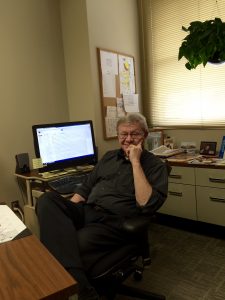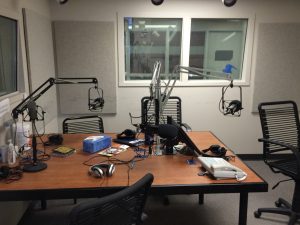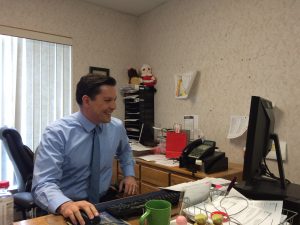
The telephone rings. On the other end of the line is an employee of the Mason-Dixon Polling and Research firm. “Do you support or oppose the continued resettlement of refugees in the Fargo-Moorhead area? Do you support or oppose public funds being used for refugee resettlement programs, such as cash assistance? Do you feel the local police departments and resettlement agencies should or should not be required to provide statistics on crimes committed by refugees?” And the list continues…
In November 2015 KVLY Valley News Live of Fargo presented their commissioned Mason-Dixon poll to its viewers. A research group of 625 participants from Cass and Clay counties were interviewed over the phone. The poll displayed the viewership’s displeasure with refugees in Fargo-Moorhead – a community commonly associated with speaking in thick Scandinavian accents and consuming large amounts of hotdish. A community where some are struggling to find their identity in the changing demographic. A community struggling with change.
KVLY’s coverage received criticism from its competitors for what they regard as sensational and misleading coverage of refugees in Fargo-Moorhead. Each media outlet in Fargo-Moorhead presented a slightly different angle and interpretation to the information about refugees in the community. These various interpretations presented by the media influenced the community’s views on New Americans, and how they affect the community.The conversation took place both over broadcast waves and in print.
A balance of opinions
As Opinion Editor at the Forum for 28 years, Jack Zaleski has seen many varying opinions cross his desk.
“There’s a small, but vocal group of people out there who don’t like the idea of settling refugees in Fargo and Moorhead,” Zaleski said. While Zaleski edits and publishes the dissenting views against refugees, that does not mean he agrees with them.
“They make a lot of noise,” he said. “They don’t make a lot of sense.”

Zaleski and The Forum try to demonstrate all sides of the argument – from the conservative to the left wing. He hopes that by sharing multiple opinions on the same issue people will think more deeply on the topic. However, he knows that, especially in controversial topics such as refugee resettlement in Fargo-Moorhead, this is not always the case.
“People who have strong views don’t want balance,” Zaleski said. “They want advocacy. They don’t want to hear the other side. They just want to hear their side.”
Bill Thomas, Director of Radio at Prairie Public Broadcasting agrees. According to Thomas, American media have become more segmented to gain a specific audience. By segmenting their coverage, media outlets can better market to a certain age range, political affiliation, or other beliefs – such as religion – that can help them gain a following.
“One thing I do know from listening to some of the other radio stations,” Thomas said, “is they have discovered that a lot of people like to listen to high intensity inflammatory talking about issues. It’s fun to hear ‘so-and-so’s an idiot…’ Being a very strong voice about what comes down to be a lot of opinion stuff.”
In beginning journalism classes, journalists are told that journalism is a “watchdog” role. A journalist is supposed to watch what is happening in the world around them and report back what is happening to the rest of society. Their professors tell them to be as objective as possible and give just the facts.
“There’s no such thing as objective” because humans are doing the work, Zaleski says. But he does note that journalists must strive to find a balance in their stories by presenting a wide ray of sources.
In recent years, it has become more common for journalists to insert their opinions into stories. It is coined as “advocacy journalism” and is meant to express a viewpoint to the consumer. At times it may be slight enough that it is not even noticeable. Other times it is jarringly apparent how the reporter feels, and how he or she wants the consumer to feel. It is separate from propaganda in that it is meant to be factual, while still expressing thoughts about a particular cause.
Charley Johnson, CEO and President of the Fargo Moorhead Visitor’s Bureau, worked in television journalism for over 30 years – most of them at KVLY in Fargo. He is frustrated by advocacy journalism – especially when it comes to hot topics like refugee resettlement. He feels that the popularity of television talk shows, radio talk shows, and social media have led to the rise of modern advocacy journalism.
This in turn leads back to segmented media, and media consumers choosing what they want to hear. Johnson notes that there are three “selectives” that news outlets keep in mind when thinking about their consumers: selective exposure, perception and retention. Selective exposure means consumers choose what they want to read and watch. Perception is that the consumer has their own bias and will perceive the story in a certain way – no matter if the reporter feels like they present the information in a straight forward factual way or not. Retention means the consumer will mainly remember what they do not agree with.
Letters “reflect what’s out there”
Zaleski understands this logic. He receives many questions, comments, and complaints about published opinion pieces and letters to the editor. One letter to the editor that gained a lot of attention suggested that North Dakota put a 20-year moratorium on allowing any more refugees to enter the state. Tim Stallman, a 62-year-old resident of Fargo, wrote the letter to The Forum in September. His main claim in the letter about Lutheran Social Services of North Dakota – the sole organization that works with refugees in the state – is a “small secretive group of unelected officials.” He is concerned about how unelected officials are using tax payers’ money for the refugee programs.
“They plot and plan to bring in more hungry mouths at your expense,” Stallman wrote. “These hungry mouths create crime and burden our schools. You pay. This is taxation without representation as well as an insult to hardworking taxpayers.”
Stallman believes that a 20-year moratorium on “immigration” will aid current new Americans a better chance to assimilate, while providing the state and elected officials time to voice their vote. This letter caused many in the community to question why such a letter would be published in The Forum.
“What someone decides is stupid or inappropriate is not my problem,” Zaleski said. “Part of our responsibility is to reflect what’s out there, and it’s out there.”
Zaleski says the opinions page is a platform to start a discussion about issues in the community. Stallman’s letter did just that.
Two days after Stallman’s initial letter, David Lanpher, Fargo, submitted his response.
“I am always struck by the bigotry involved in the resettlement of refugees in our community,” he wrote. “I have met many of these who are coming into our community to find the American dream of safety for their families, steady work to provide for their families, and the making of a better life.”
The discussion continued on the Forum’s editorial pages as Stallman submitted another letter in November. This letter declared his disgust for the Forum’s “bias against a more thoughtful and comprehensive policy for immigration that would include slowing down the rate of immigration as well as creating more transparency in allowing taxpayers to see what is actually being spent on this flood of immigrants.”
“Call your congressman or senator and demand answers,” Stallman wrote. It’s your tax money.”
Both Matt Von Pinnon, editor of The Forum, and Zaleski agree that the opinion side of the newspaper are supportive of the refugee resettlement program in the region.
“If you even look at the news coverage, it has been objective and fair and balanced and all those kind of things, but just because we do carry that voice publically, we probably tend to be seen as more sympathetic or supportive of refugee resettlement,” Von Pinnon said.
Zaleksi said The Forum has been strong in supporting the refugee program for a long time.
“This isn’t new with this latest dust up we’ve had around here because of the change in the world climate [with] how we feel about new comers,” he said.
Covering refugee resettlement as news
The Forum has further shown support of refugees in the area through 2015’s “Area Person of the Year” award. The Forum awarded Jessica Thomasson, CEO of LSS of North Dakota.
In a December 2015 Forum article, reporter Robin Huebner wrote, “Forum editors named Thomasson the 2015 Area Person of the Year because she serves as a lightning rod for that criticism and leads an agency with great impact on the region.”
Thomasson is the tenth recipient of the award.
Von Pinnon acknowledges that Thomasson was a controversial choice, but he stands by The Forum’s decision.
“Some people were upset… because they think it’s an endorsement of her or the agency,” Von Pinnon said.
Every year the Forum picks their “Area Person of the Year” based on someone they view has a “large impact on the community.” People from the community nominate candidates, but the editors ultimately decide the winner.
“We own it,” Von Pinnon said. “We don’t shy away from it.”
Prairie Public Radio has not done as extensive coverage on new Americans. Three stories were featured on air in 2015 and six stories in the summer of 2013. Stories featured in 2015 included Jessica Thomasson of LSSND, a Syrian immigrant (someone who left voluntarily), and a feature on National Welcoming Week – a week that focuses on welcoming new immigrants. Part of Prairie Public’s lesser coverage is due to lack of funding, but it is also partially by design.
“We definitely value giving the right people a lot of mic time,” said Ashley Thornberg, a contributing reporter at Prairie Public. “A lot of clearing the air.”
Public radio has the leisure of waiting to do a story for when they feel they have more of the facts. They do not have the same time constraints as a daily commercial news organization. This was a hard transition for Thornberg to handle when she joined Prairie Public.
“When I first switched over from commercial news to public broadcasting, I did sort of say, ‘Hey! This happened today. Why isn’t anyone covering this?!?’” she said. “And I do think we could do a better job covering stuff day of, but in some cases it is nice to wait a day or two to see how the reaction plays out… Once people have gotten over that initial reaction – that fear, that anger, that sadness, they’re going to be more open to listen to a long form discussion.”
Prairie Public has a unique platform in that they are the only station with statewide coverage. All of the other news organizations in Fargo-Moorhead focus on the immediate communities and reach some of the surrounding area.
The stories that aired in 2013 show that resentment against refugees is not a new issue in Fargo-Moorhead.
Prairie Public’s Director of Radio Bill Thomas says he has heard resentment against refugees for the 16 years he has lived in Moorhead and worked in Fargo. He feels that this resentment can be categorized in a couple ways. One is the attitude of “we’re subsidizing these people; we’re giving them special treats and breaks.” Thomas has heard this from people who “have a kind of small government, antigovernment attitude like the government shouldn’t be in the business of subsidizing and helping people” – much like the thoughts Stallman expressed in his letter to The Forum.
The other main group of people Thomas hears this attitude from is surprising. Native Americans.
“American Indians express great resentment toward the refugee resettlement programs because they feel like, ‘Why is the U.S. government treating these people so nice; they treat us so bad,’” he said. He stresses that he has seen that since he first moved to the region.
The other attitude Thomas hears is the fear of change. He hears from people who fear that current traditions and customs may be lost – and who are afraid of the new “weird people with their weird ways and their weird food and their weird customs.”
Changing attitudes about refugees
While it appears that concern about refugee resettlement reached another peak during November of 2015, these concerns have come in waves for years. Both Thomas and Zaleski noted concerns about refugee resettlement can be traced back to right after World War II when some of the first refugees arrived in the United States. LSS of North Dakota also makes this clear in informational documents about the refugee resettlement program. The first refugees came through LSS in 1948. These people were displaced by the war and the advancement of the Soviet Union.
Many people welcomed these refugees from the horrors of the war. They were viewed as “innocent people fleeing fighting,” Thomas said. The focus then shifted to refugees fleeing from communist nations – another situation Americans could fully support. Thomas can easily relate to refugees fleeing communism. One woman from eastern Europe lived with his family. She had to flee because of a “failed revolution” against the “Soviet domination” in her country.
When Cuba fell to Castro’s communism, many Cubans fled to the U.S. Again, many Americans felt that they should help these people flee the evils of communism.
“Refugee was a very sympathetic term,” Thomas said. “The overtones were very much, ‘These are people we should help; they’re getting away from something awful, and we can provide them respite and a chance to have a life.’”

WDAY reporter Kevin Wallevand remembers these sentiments in Fargo. For many years a television crew from WDAY would go out to Fargo’s Hector International Airport and cover the arrival of new Americans and their families.
“It was a big deal,” Wallevand said.
After a while, Wallevand says the community’s thoughts shifted from welcoming to wondering. What are these people fleeing? Would they bring those issues with them? Do these people contribute to the crime in our neighborhoods?
Zaleski says that some people in the community associate refugees not as people fleeing trouble but as the trouble they fled from. No longer is the refugee the poor, innocent person fleeing destruction; the refugee is a carrier of the trouble they fled.
Attitudes reflect confusion and fear
There also appears to be some confusion in the community between refugees and immigrants – whether legal or illegal immigrants. Von Pinnon thinks some people equate Mexican immigrants coming over the border into the United States with Syrians being resettled here. However, he stresses that this is not the case, and the Forum tries to tell the public this information.
“There is a difference,” he said. “Some people are choosing of their own volition to come here… Refugees are really escaping something, you know. They’re not necessarily coming to the United States, coming to our area by totally choice. They’re trying to get away from something.”
The idea of refugees bringing violence and trouble from their home countries is strengthened through commentary from the November attacks in Paris and the San Bernardino shooting in December.
Both Kevin Wallevand of WDAY and Matt Von Pinnon of the Forum agree that concerns about refugees in the area come in waves. These waves of concern and emotion are influenced and exacerbated when terrible events like the attacks in Paris and San Bernardino occur.
Von Pinnon thinks some people are mainly concerned about Syrian refugees. He says that people are more sensitive to Syrian refugees “because there are many people who associate that population with terrorists.”
In the case of the Nov. 13, 2015 attacks in Paris, this fear was fueled when a Syrian passport was found on one of the attackers.
This information enhanced people’s fears about migration and the need to further vet refugees. A March 18, 2016, BBC article, “Paris attacks: Who were the attackers,” reported that it was later believed that the passport found on Ahmad al-Mohammad was a forgery – made to instill fear and suspicion in Syrian immigrants and refugees. Most of the men cited in the BBC article were French or Belgian nationals.
In a Nov. 14, 2015, NPR article, “Paris Attacks: What we know on Saturday,” the authors wrote, “Witnesses say the gunmen shouted ‘God is great’ in Arabic and ranted about Iraq and Syria French authorities said…”
This statement in combination with ISIS claiming responsibility for the attack further led some people to suspect refugees of terrorism – especially those practicing Islam.

Prairie Public’s Ashley Thornberg believes this fear is further enhanced by America’s current reporting styles.
American news media’s segmentation includes its segmentation of opinions and fixation on topics. Thornberg talked of American media’s focus on an event “24 hours a day” for weeks at a time. Thornberg gave the example of the “very consistent over the top coverage” of the Paris attacks as they were reported in the U.S.
“The coverage [in France] was very different,” she said. “It’s not that the French weren’t covering it, but I was, frankly, really proud of a French journalist who, when somebody immediately started saying, ‘Well, if French people had concealed carry permits, they could’ve shot these guys… He [the French journalist] immediately said, ‘This isn’t the time for speculation. Right now is a time of mourning and fact gathering.’”
Thornberg feels that American journalism jumps too quickly to rely on speculation and politics rather than the fact. But for Thornberg, crying wolf all of the time is not effective.
“I thought the overall coverage in France was much more effective because there was something in it being presented sort of calmer that made it more effective,” she said. “You really get into the nuances and the causes of the behavior.”
As former KVLY anchor Charley Johnson stated, much of American media is becoming advocacy journalism. News broadcasts create more of a production in order to stir up emotions. The French coverage made a bigger impact while letting the public make their own decisions on current issues.
KVLY comes up against criticism
Some news media outlets in Fargo-Moorhead are forthright that they have an opinion to share with their consumers.
Members of the Forum will openly admit their editorial stance of standing with refugees in the community. Jack Zaleski and columnist Mike McFeely have both written against refugee coverage done by KVLY. It is important to note that the Forum is owned by Forum News Service which also owns WDAY, KVLY’s competitor. In a December column, McFeely accused KVLY of misconstruing facts and fanning “Islamophobic flames.”
Bill Thomas also acknowledges KVLY’s coverage as differing from Prairie Public’s approach.
“It seems to me, and I’m only saying this by inference,” he said, “KVLY made a decision that, ‘Hey, this a story that will get us some viewers and up our ratings, so we’re going to kind of go with this ‘refugees are a problem’ story and really play it up.”
Thomas thinks KVLY made this as a decision to up rankings and gain viewers.
“I didn’t see it as a real news driven decision,” he said.
Zaleski agrees.
“I think it was an attempt to raise their [KVLY’s] ratings to knock off [W]DAY, which has been the ratings king here for longer than I’ve been in town,” he said.
KVLY ran a four-part series focused on LSS and refugees in Fargo in November 2015. Bradford Arick is their designated “immigration and relocation” reporter.
Topics included the controversial Mason-Dixon poll, education, crime, and LSS. In the first report of the series, Arick says that all of the stories were based off of the answers of the from the 625 person poll. The participants were selected at random. Only 28 percent of people responded that they support refugee resettlement, while 57 percent responded that they oppose it. The last 15 percent were undecided. Many questions follow. All answers in the poll show a very negative response to refugees in Fargo-Moorhead.
Because the stories were based off of the negatively worded poll, many of the stories carry a negative connotation against refugees. This has been a point of contention between the pro-refugee Forum and the seemingly anti-refugee Valley News Live.
Arick was interested and excited to be interviewed for this story, but after talking to KVLY’s news director Ike Walker, Arick said he could not participate. Walker could not be reached for comment.
During a phone call with Arick, he asked if this story would be an “attack piece” on Valley News Live and KVLY.
This question came about as some in the community have been critical about KVLY’s reporting styles.
Jack Zaleski is one of them.
“They have no standards at all,” Zaleski said. “They tilt so heavily towards the sensationalism that they often get caught doing unethical stuff.”
Zaleski clarified that his frustration is with the management and directors at the station not the reporters.
“There are some very good journalists over there [at KVLY] who are caught up in that system,” he said, “and it’s too bad because they could do better.”
Valley News Live added to its coverage of refugee issues with additional commentary from Chris Berg’s commentary show 6:30 Point of View. As the title suggests, the show is based around people’s opinions and points of view about topics and issues within Fargo-Moorhead and the state of North Dakota.

Berg highlights what the topics of discussion will be for the broadcast; then, people in the community can send in emails, texts, phone calls, and tweets with their opinions. Berg hosts a round table discussion with others from the community who may be knowledgeable on the topic, as well as hosts one-on-one interviews.
Every show begins with a text disclaimer which reads, “The views expressed on this program are those of the commenter alone. They do not represent the views or opinions of Valley News Live, our parent company, or our advertisers.” Following that announcement, Point of View blurs the lines between talk show and newscast. Berg is often centered at a table in a position that makes him appear to be a news anchor. Video clips and sound bites are produced and used in the same way they could be used in the previous hour’s news cast. Tags and captions are abundant. If someone missed the beginning disclaimer, they could mistake the show for a newscast.
Topics on the show fluctuate depending on “what’s hot” in the community. For a while that topic was refugee resettlement in the community.
“One woman that jumps out to me specifically,” Berg said. “[She said] Chris, I’m scared. I live alone… and this stuff needs to stop [in reference to refugee resettlement in the U.S.].”
In many ways he describes his show just as Zaleski would describe the opinions page of the Forum. Berg wants his show to be a place where conversation about topics begins.
The are many differences between the Forum’s opinions page and KVLY’s Point of View, but the biggest difference is how the two media function. Print letters are edited somewhat; on air broadcast has added pressures of time allowance. This can lead to a host guiding conversations to fit a time frame.
During Point of View, there are many interviews where Berg speaks over his guests to guide the conversation.
“I don’t mean to cut you off, but…” is a phrase Berg uses frequently.
“I want you to hold that thought…” is another.
Another difference in broadcast media is the use of vocal inflection and, in the case of television, facial expressions. Sometimes an issue may be made to seem more dire through the use of vocal inflection.
During his shows concerning refugee discussions, Berg relied heavily on KVLY’s Mason-Dixon poll. When prefacing a question to his guests, those numbers are brought up. When a guest objects to the statistics Berg tells them to look at the poll.
This poll has led some in the community – including competing news organizations – to question who consisted of the base of this poll.
For Berg, the fact that the poll was conducted by a company outside of KVLY stresses its objectivity and validity.
For others, the negative responses demonstrate the need to better inform the public.
“A lot of times you can be afraid of the unknown, and that doesn’t make you a bad person,” Thornberg said. “It makes you uninformed or misinformed, and there is a difference between being uninformed and misinformed about a situation.”
Berg disagrees.
“I hate to say misinformation because I honestly believe people want to know the truth,” he said.
Berg believes the “average Joe” is preoccupied with other parts of life. He thinks the added complexity of differences between VISAs and refugee resettlement make it unrealistic to expect the public’s total understanding.
“They’re trying to put food on the table, pay their bills, pay their mortgage, make their family happy, and, you know, now ‘I have to go study about VISAs and resettlement?’ Really?” he asked.
Fear of change
In the end, the underlying concerns of the community – whether heard on the airwaves or read in the paper – seem to boil down to one fear – the fear of change.
Von Pinnon has seen many of these concerns appear in the Forum’s pages.“There is a fear in that somehow they [refugees] will change the American culture from within,” he said.
One of the commonly voiced concerns?
“‘Pretty soon we won’t be a Christian nation,’” Von Pinnon said. “We hear that a lot, but that it will be an Islamic [nation] – pick a challenging religion or whatever.”
Prairie Public’s Bill Thomas has heard concerns from many people. They are afraid of losing the long established local traditions, but they were also afraid of the state’s declining population.
“It wasn’t that long ago that people would say, ‘Last person out of North Dakota, don’t forget to turn off the lights,’” he said.
Civic leaders told Thomas the only way to change the “decline of North Dakota” was to get people to move to the state.
“Everybody goes, ‘Oh! Oh! Our town’s dying,’” Thomas said. “But then we talk about getting new people to move here, and they go… ‘They’ll make it different, and we don’t want that.’ And it’s like, well, you can’t have both.”
Change is inevitable. New Americans and new people in communities will make things different. Talk will happen in local cafes and in church basements. People will share their opinions on the changing situations. The media plays an active role in affecting those opinions. The media’s interpretation and representation greatly affect the conversations in communities in North Dakota. Will the community embrace the change or resist it?
Only time will tell.
This piece was completed for the Investigating and Narrating the News course where all students reported on refugee issues and stories in Fargo-Moorhead.

